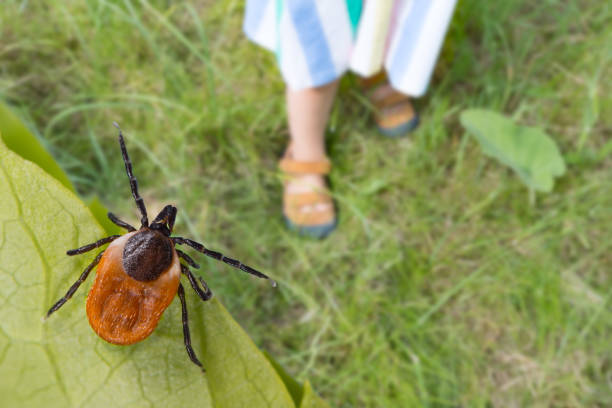Saturday, February 11, 2023
Lyme disease and co-infection are among the most common tick-borne diseases, along with: babesiosis, anaplasmosis, ehrlichiosis, relapsing fever, tularemia, and Rocky Mountain spotted fever.
This tick-borne infection is a zoonotic infection. This does not mean that ticks are the main source, but ticks transmit it from other animals, such as mice, rats, and squirrels, to humans.
Through a single bite, ticks can transmit many bacteria and viruses at the same time, and diseases acquired together at the same time from a tick bite are called co-infections.
What is Lyme disease?
Lyme disease is a bacterial infection that begins after being bitten by a tick carrying H. pylori or several subspecies of the bacteria.
The tick sticks to its host for 36 to 48 hours to transmit the bacteria, and after its bite to humans, this bacteria begins to spread in the body through stages, and this is the reason for the importance of prompt treatment.
If you spend a lot of time in places where ticks live, such as grassy areas or areas with dense trees such as forests, you are at increased risk of contracting Lyme disease.
What is the cause of Lyme disease?
The main cause of transmission of Lyme disease is ticks, as it transmits various types of Borrelia bacteria to humans. The black tick carries this bacteria, also known as black-legged ticks, or deer ticks..but how does it do that?
The tick sticks to the host’s body to feed on its blood, begins to swell to several times its size, and can feed on its body for several days.
The tick picks up the bacteria from the host, which may be an animal such as deer or a rodent such as rats. The infected tick then goes on to feed on a person’s blood, and then transfers the bacteria it carries into the person’s bloodstream.
There is a small chance of a person being infected with Lyme disease if the tick is removed within 24 hours.
Here are some of the contributing factors to getting a Lyme infection:
- Being in an area where ticks are infested: Ticks live in wooded and grassy areas.
- Time of year: It’s common for tick activity to increase during the hotter seasons of the year, so you’re more likely to be bitten in the spring and summer.
Lyme disease symptoms
Untreated Lyme disease produces a group of symptoms, depending on the stage of infection, and may include: fever, rash, facial paralysis, arthritis, and others.. according to Centers for Disease Control and Prevention. The following are the symptoms of Lyme disease, depending on the stage it has reached:
Stage I: Early signs and symptoms (3 to 30 days after the tick bite)
3 to 30 days after a tick bite, you may develop the following symptoms:
- fever and chills
- headache.
- Exhaustion.
- Muscle and joint pain.
- Swollen lymph nodes in the absence of a rash.
- A rash of erythema migrans, affecting 70 to 80 percent of patients, begins to expand until it is 30 cm or more in width.
Stage 2: Later signs and symptoms (days to months after the tick bite)
After passing the first stage of infection, and the passage of days to months of infection, symptoms develop into:
- Severe headache.
- Stiffness in the neck.
- additional rash.
- Facial paralysis (drooping of one or both sides of the face).
- Arthritis with severe pain and swelling (especially of the knees and other large joints).
- Intermittent pain in tendons, muscles, joints and bones.
- Heart palpitations (carditis).
- Dizziness or shortness of breath.
- Encephalitis and spinal cord.
- Numbness or tingling in the hands and feet.
Lyme disease co-infection (this title has been added)
Lyme disease co-infection is when ticks transmit another Lyme disease co-infection to humans. This co-infection and its clinical impact were first identified in 1990, ten years after the discovery of Lyme disease.
Co-infections can exacerbate Lyme disease. The following are the types of infections associated with Lyme:
Babesiosis
Babesia is a malaria-like parasite, also called piroplasm, that infects red blood cells. In addition to transmission through tick bites, babesiosis can be transmitted from mother to fetus or through transfusion of contaminated blood.
Bartonella
Bartonella is a bacterium that lives in the lining of blood vessels, infecting both humans, mammals, and wild animals. The disease caused by these bacteria is called bartonellosis. In addition to tick bites, ticks can be transmitted through cat scratching.
Spotted Fever Rickettsia
This condition is caused by the rickettsia bacteria, which can be found in lice, fleas, and mites, with ticks being the main vector. These bacteria cause two different groups of diseases: the spotted fever, and the typhus group.
Ehrlicia and Anaplasma
It is transmitted by ticks, and its clinical symptoms include a sudden rise in temperature, fatigue, muscle pain, and headache.
People with other serious illnesses may experience:
- Low white blood cell count and low platelet count.
- Anemia.
- Elevated liver enzymes.
- Kidney failure.
- Respiratory failure.
The elderly or people with weakened immune systems may need to be hospitalized, and they are more likely to die.
Other infections associated with Lyme disease
In addition to the co-infections listed above, you may develop one or more of the following co-infections:
- Colorado tick fever virus.
- mycoplasma.
- Encephalitis virus.
- Rocky Mountain spotted fever (rickettsia).
- Tick-borne relapsing fever.
Complications of Lyme disease
Complications of Lyme disease, or symptoms that persist even after treatment, include:
- Body aches and pains.
- Constant feeling of tiredness.
- memory problems.
- Arthritis that does not improve.
This is a complication called post-treatment syndrome for Lyme disease.
These long-term complications may be caused by:
- The immune system’s response to dead bacteria.
- Recurrent Lyme infection.
- incomplete treatment.
- Autoimmune damage to healthy tissue.
Lyme disease and pregnancy
When infected with Lyme disease during pregnancy, this can lead to infection of the placenta, and then transmission of the disease from mother to fetus, but it is a rare possibility.
Lyme disease treatment
For Lyme infection, your doctor will prescribe antibiotics. The doses depend on your symptoms, and you may need to take them for up to 28 days even if you start to feel better.
Antibiotic treatment
In Lyme disease, in the early stages, short doses of oral antibiotics are prescribed.
In more complicated and advanced cases, Lyme disease usually clears up within three to four weeks of antibiotic treatment.
Patients with Lyme symptoms that persist for a long time after treatment are referred to a specialist and get more blood tests. They may also be given antibiotics intravenously.
Lyme disease prevention
In order to prevent Lyme disease, be sure to follow these guidelines, especially if you are in wooded or grassy areas:
- Cover your skin while walking outdoors and tuck your pants into your socks.
- Apply tick repellent to your skin and clothing: Use an insect repellent that contains lemon eucalyptus oil or para-menthane diol.
- Apply this product to your children, avoiding hands, eyes, and mouth.
- Treat clothing and gear, such as shoes, pants, and socks.
Frequently asked questions that may interest you
Is Lyme disease dangerous?
Yes, Lyme disease is serious. If left untreated, it can lead to:
- facial paralysis
- Swelling of large joints.
- changes in heartbeat
Is Lyme disease contagious?
No, Lyme disease is not transmitted from person to person through physical contact or through the air or food.
However, Lyme bacteria have been detected in human body fluids, such as: blood, semen, and vaginal secretions. However, scientists have not linked any cases of Lyme disease infection to these fluids.











